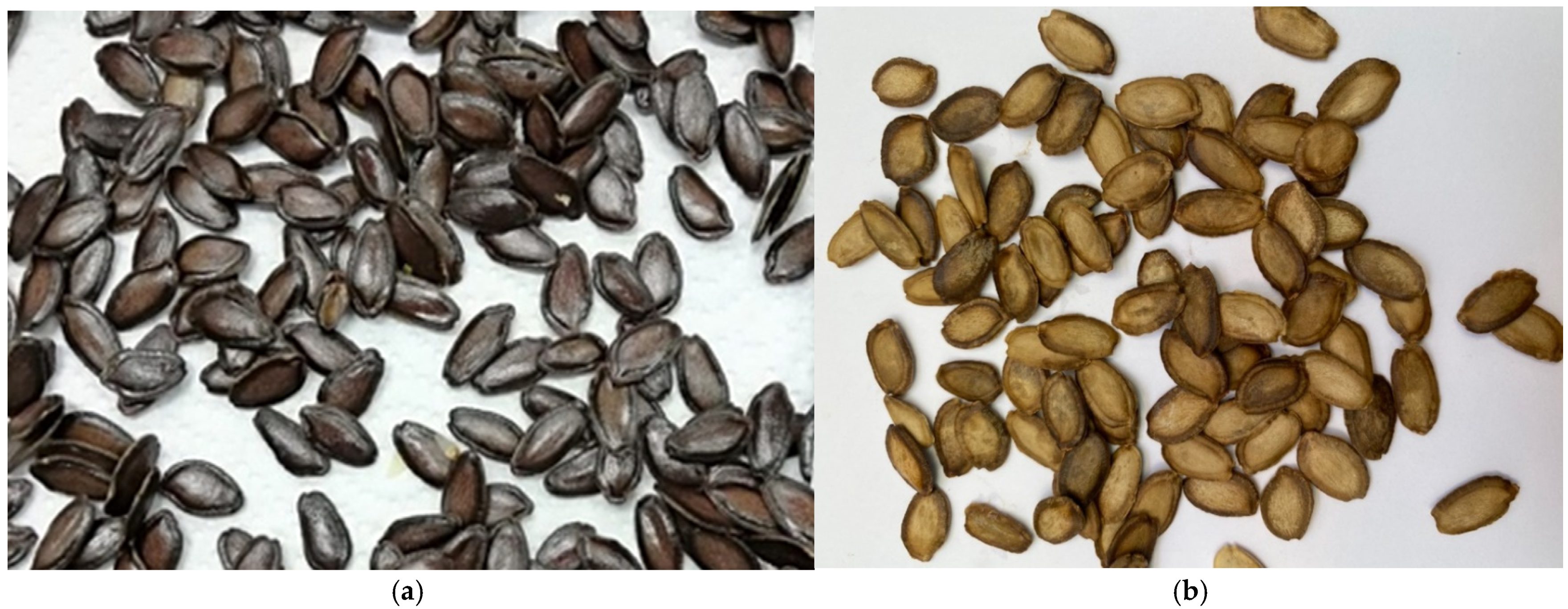Oil Characterization and Seeds Composition of Sicana odorifera, an Ancestral Cucurbita from Paraguay †
Abstract
:1. Introduction
2. Materials and Methods
2.1. Plant Material
2.2. Obtaining the Oil
2.3. Analysis
2.4. Statistical Analysis
3. Results
3.1. Proximal Composition
3.2. Characterization of the Oil and Fatty Acid Profile of the Seeds
4. Discussion
5. Conclusions
Institutional Review Board Statement
Informed Consent Statement
Data Availability Statement
Acknowledgments
References
- De Paula Filho, G.X.; Barreira, T.F.; Pinheiro, S.S.; de Morais Cardoso, L.; Duarte Martino, H.S.; Pinheiro-Sant’Ana, H.M. ‘Melão croá’ (Sicana sphaerica Vell.) and ‘maracujina’ (Sicana odorifera Naud.): Chemical composition, carotenoids, vitamins and minerals in native fruits from the Brazilian Atlantic forest. Fruits 2015, 70, 341–349. [Google Scholar] [CrossRef]
- Albuquerque, B.R.; Dias, M.I.; Pereira, C.; Petrović, J.; Soković, M.; Calhelha, R.C.; Oliveira, M.B.P.P.; Ferreira, I.C.F.R.; Barros, L. Valorization of Sicana odorifera (Vell.) Naudin Epicarp as a Source of Bioactive Compounds: Chemical Characterization and Evaluation of Its Bioactive Properties. Foods 2021, 10, 700. [Google Scholar] [CrossRef] [PubMed]
- Horwitz, W. Official Methods of Analysis of the Association of Official Analytical Chemists, 17th ed.; AOAC: Gaithersburg, MA, USA, 2000. [Google Scholar]
- Firestone, D. (Ed.) Official Methods and Recommended Practices of the American Oil Chemist’s Society AOCS, 6th ed.; AOCS: Urbana, IL, USA, 2009. [Google Scholar]
- Shahangir, A.H. Nutritional and Lipid Composition Analysis of Pumpkin Seed (Cucurbita maxima Linn.). J. Nutr. Food Sci. 2015, 5, 374. [Google Scholar] [CrossRef]
- Ortiz Grisales, S.; Pasos López, S.; Abadía Rivas, X.; Valdés Restrepo, M.P.; Vallejo Cabrera, F. Extracción y caracterización de aceite de semillas de zapallo. Acta Agronómica 2009, 58, 145–151. Available online: https://www.redalyc.org/articulo.oa?id=169916219005 (accessed on 15 September 2021).
- Hernández-Pérez, T.; Valverde, M.E.; Orona-Tamayo, D.; Paredes-Lopez, O. Chia (Salvia hispanica): Nutraceutical Properties and Therapeutic Applications. Proceedings 2020, 53, 17. [Google Scholar] [CrossRef]

| Parameter | Black Kurugua Seeds | Red Kurugua Seeds |
|---|---|---|
| Moisture (g/100 g) | 10.63 ± 0.23 a | 7.70 ± 0.26 b |
| Ash (g/100 g) | 2.48 ± 0.14 a | 2.64 ± 0.02 b |
| Total protein (g/100 g) | 17.40 ± 0.81 a | 18.55 ± 0.55 a |
| Total lipids | 34.50 ± 0.28 a | 36.3 ± 0.49 a |
| Total carbohydrates (g/100 g) | 2.78±0.06 a | 3.40 ± 0.32 a |
| Dietary fiber (g/100 g) | 34.75 ± 0.27 a | 39.94 ± 0.08 a |
| Caloric Value (Kcal/100 g) | 391± 2.57 a | 415± 4.67 b |
| Variety | Iodine Value (gI2/100 g) | Saponification Index (mg KOH/g) | Density (g/mL), 25 °C | Refractive Index ND, 25 °C |
|---|---|---|---|---|
| Black fruit seeds | 132.76 ± 2.29 a | 166.88 ± 0.30 a | 0.87 ± 0.02 a | 1.479 ± 0.33 a |
| Reddish fruit seeds | 130.58 ± 2.00 a | 182.42 ± 0.00 b | 1.09 ± 0.00 b | 1.478 ± 0.00 a |
| Fatty Acids | Reddish Fruit Seeds (g/100 g Oil) | Black Fruit Seeds (g/100 g Oil) | |
|---|---|---|---|
| Polyunsaturated | Linolenic (ω-3) | 32.80 ± 0.13 a | 38.08 ± 0.06 b |
| Linoleic (ω-6) | 28.62 ± 0.17 a | 29.51 ± 0.21 b | |
| 8.11 octadecadienoic Acid. | 1.26 ± 0.03 a | 1.18 ± 0.01 a | |
| Monounsaturated | Oleic (ω-9) | 19.39 ± 0.11 a | 13.16 ± 0.55 a |
| Palmitoleic (ω-7) | 0.09 ± 0.01 a | 0.06 ± 0.01 a | |
| TOTAL | 82.16 | 81.99 | |
| Saturated | Miristic (14:00) | 0.12 ± 0.02 a | 0.12 ± 0.01 a |
| Palmitic (16:00) | 10.98 ± 0.17 a | 10.93 ± 0.08 a | |
| Estearic (18:00) | 6.74 ± 0.07 a | 6.96 ± 0.17 a | |
| TOTAL | 17.84 | 18.01 | |
Publisher’s Note: MDPI stays neutral with regard to jurisdictional claims in published maps and institutional affiliations. |
© 2021 by the authors. Licensee MDPI, Basel, Switzerland. This article is an open access article distributed under the terms and conditions of the Creative Commons Attribution (CC BY) license (https://creativecommons.org/licenses/by/4.0/).
Share and Cite
Mereles, L.; Coronel, E.; Galeano, L.; Caballero, S. Oil Characterization and Seeds Composition of Sicana odorifera, an Ancestral Cucurbita from Paraguay. Biol. Life Sci. Forum 2021, 8, 2. https://doi.org/10.3390/blsf2021008002
Mereles L, Coronel E, Galeano L, Caballero S. Oil Characterization and Seeds Composition of Sicana odorifera, an Ancestral Cucurbita from Paraguay. Biology and Life Sciences Forum. 2021; 8(1):2. https://doi.org/10.3390/blsf2021008002
Chicago/Turabian StyleMereles, Laura, Eva Coronel, Loida Galeano, and Silvia Caballero. 2021. "Oil Characterization and Seeds Composition of Sicana odorifera, an Ancestral Cucurbita from Paraguay" Biology and Life Sciences Forum 8, no. 1: 2. https://doi.org/10.3390/blsf2021008002
APA StyleMereles, L., Coronel, E., Galeano, L., & Caballero, S. (2021). Oil Characterization and Seeds Composition of Sicana odorifera, an Ancestral Cucurbita from Paraguay. Biology and Life Sciences Forum, 8(1), 2. https://doi.org/10.3390/blsf2021008002







